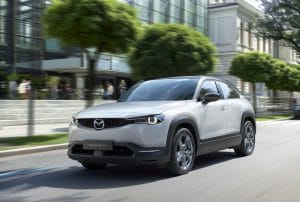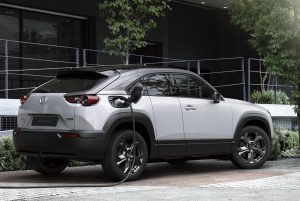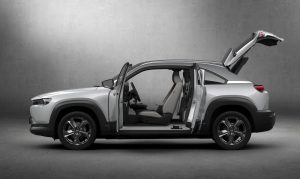Mazda has made no secret of the fact that it’s finally – belatedly – getting into the EV game with the new MX-30, but when the automaker officially lifted the covers on the production model it did manage to deliver a surprise: the first version of the compact crossover will be a hybrid.
The “mild” hybrid will utilizes a 2.0-liter version of the Mazda SkyActiv-G gas engine paired with an electric motor assist system, and will go on sale in Japan this autumn. It appears that the battery-electric version is now being pushed back into the 2021 calendar year, though it will begin taking orders before the end of 2020 in Japan and Europe.
We’ll have to wait for more details about the MX-30 – which we do know shares the basic platform with Mazda’s more conventional CX-30 crossover. The all-electric version is expected to first appear in Europe and then come to the U.S. within the next 12 months or so, but Mazda, for now, isn’t offering details about global plans for the hybrid.
(Mazda celebrates 100 years with special edition Miata.)
Mazda has been one of the more reluctant automakers when it comes to electrification, preferring to stick with ever more efficient variations on its SkyActiv technology, including the –D and –X packages. The SkyActiv-D, no surprise, is a diesel. The SkyActiv-X is a breakthrough technology using what’s roughly described as a Homogenous Charge Compression Engine. Think of it as a system that delivers diesel-like efficiency but runs on less expensive gasoline.
But, in today’s world of ever-stricter emissions and fuel economy regulations, those won’t clear the hurdle without at least some help.
What we know is that the all-electric version of the MX-30 will use a single, front-mounted 143-horsepower electric motor drawing power from a 35.5 kilowatt-hour lithium-ion battery. That’s barely 60% of the energy capacity of a Chevrolet Bolt, which would suggest a range of somewhere under 125 miles per charge target, a bit less than what the base version of the second-generation Nissan Leaf can manage.
Considering the evolution of the EV market, it’s questionable just how much demand there will be for such a limited-range offering. It could play well in some markets, such as Europe and Japan, but the new norm in the U.S. appears to be north of 250 miles per charge. A hybrid alternative could prove a better option in North America, though Mazda isn’t ready to reveal plans.
(A Week With: 2020 Mazda3 Hatchback AWD.)
Using a 50 kilowatt quick charger, it’s expected to deliver about 80% of capacity in 40 minutes.
Mazda isn’t offering any stats on the MX-30 hybrid but we know that the 2.0-liter SkyActiv-G makes 154 horsepower and 147 horsepower in the Japanese domestic market version of the Mazda3.
We got our first look at a near market-ready version of the MX-30 EV at the Tokyo Motor Show late last autumn. The hybrid version appears to be essentially identical in design. The most notable details include ring-style LED headlights, a relative short hood, a coupe/crossover style roofline and pillarless, suicide-style rear doors with no visible handles
The cabin, Mazda emphasized in Tokyo last autumn, makes heavy reliance on renewable materials. The IP features twin digital display, one for climate and vehicle controls, the other for infotainment settings and the backup camera. The MX-30 also is expected to come with a standard suite of advanced driver assistance technologies, the Mazda I-Activesense system, including forward collision warning with auto-braking, and lane-keeping assist.
(Mazda has done better than expected during the pandemic-fueled auto sales slowdown.)
While Mazda has been slow to plug in on electrification, it is planning to change that. “By 2030, every car we make will feature our e-SkyActive electric-drive technology as we work to reduce carbon dioxide emission,” Akira Marumoto, Mazda’s chief executive, said at the 2019 Tokyo Motor Show.



